Empowering the IoT Ecosystem: Matter and Qorvo Provide Designers with a Game-Changing Boost
November 27, 2023
Funny thing about growing pains—for all the initial discomfort, there’s often positive growth and improvement when it’s all said and done. Smart home technology is in a growth spurt right now. In fact, its development and expansion are likely to explode on the market. Given the capabilities of modern applications, you’d think smart homes would be well on the way to being the norm. So, why the hold-up?
Well, until recently, there’s been a myriad of standard and non-standard systems, devices as well as applications that many times just didn’t work and play well together. A great deal of the problem was in technology fragmentation. Different IoT devices don’t always recognize each other. Many require their own app or network to communicate, as shown below (Figure 1). It wasn’t unusual for early adopters’ smartphones to be overstuffed with apps—one for lighting, another for security, a third for temperature control, and the list goes on. Likewise, early smart homes could be chock full of devices to the point of needing one in each room for various applications.
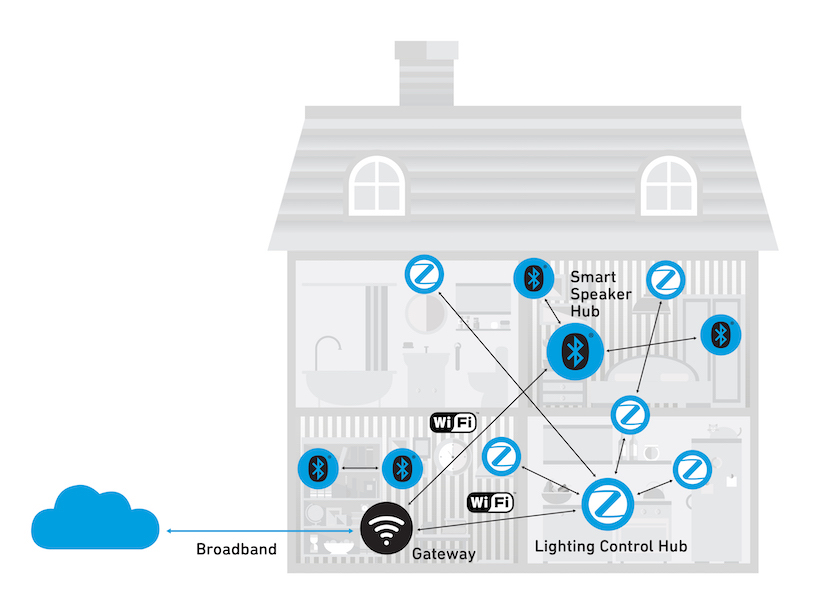
Take a Deeper Dive: Read Our Technical Articles
How Qorvo Enables IoT Interoperability
Learn How Qorvo Supports the Matter IoT Ecosystem
Qorvo’s Recommended Guide for Connected IoT Designs
From Ideation to Realization with Qorvo’s IoT Dev Kit Pro
Enter Matter
But things are looking up. The ideal solution would provide consumers with plug-and-play devices and networks while giving manufacturers a profitable standard, and that’s where Matter comes in.
The Matter standard is now a driving force in what has been a fragmented smart home device market. It helps manage wireless gateways, room-to-room extenders and smart devices running throughout a smart home’s various standards.
The unification process started in earnest in March 2021 when the Zigbee Alliance changed its name to the Connectivity Standards Alliance (CSA) to position itself as a trusted advocate of safe, interconnected IoT. Additionally, in 2021, the CSA announced the brand of its new IoT protocol called Matter. Driven by industry leaders like Amazon, Apple, Google and Samsung, Matter provides interoperable control of the current patchwork of standards, including Wi-Fi, Thread, Bluetooth® and Zigbee. The goal was to achieve essential interoperability of smart home ecosystems, devices and apps, along with simplified setups and built-in security measures. The CSA was able to announce Matter ratification industry-wide in October 2022. Amazon and IKEA followed with announcements using Matter in their Echo and smart home hub products.
Wi-Fi Advances Make the Most of Matter
Matter and high-performing tri-band Wi-Fi mesh networks are expected to yield ongoing innovation in the smart home. As shown below in Figure 2, today’s Wi-Fi home and business architectures are moving to distributed Wi-Fi or Wi-Fi Easy Mesh. They’re based on a “pod per room” architecture and are becoming more commonplace.
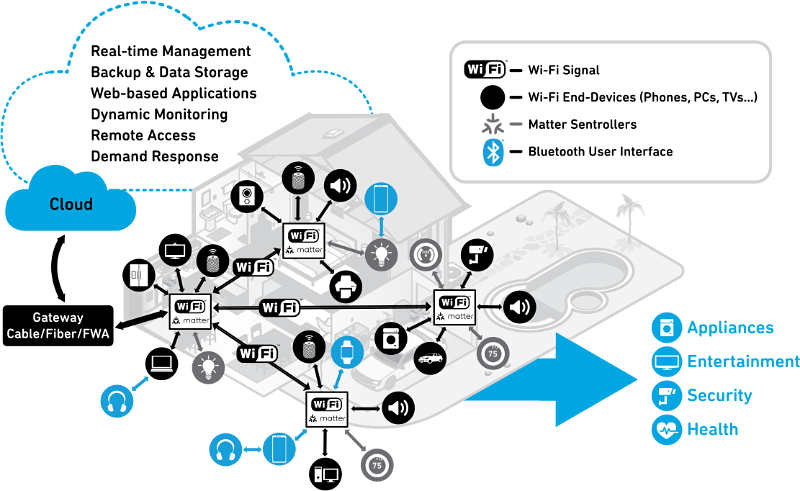
A Qorvo white paper titled "Wi-Fi 6 and Matter: The Real Plug and Play Smart Home" laid Matter’s technical foundations. Essentially, Matter resides in a layer of the technology stack between the network/transport and application layers, employing the various connectivity standards mentioned above to suit different purposes, as shown in Figure 3.
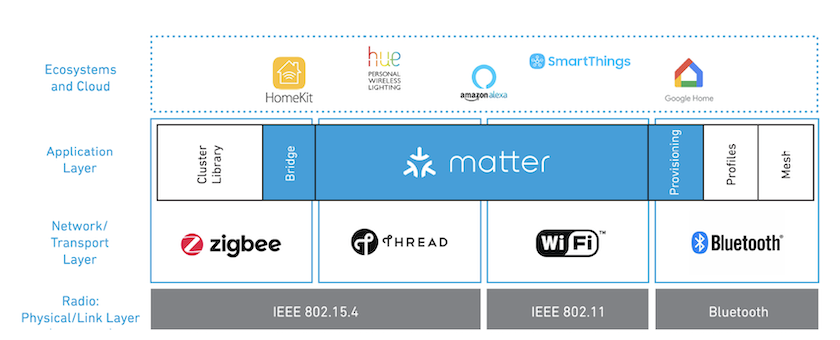
Matter helps orchestrate the smart home ecosystem, devices and applications on multiple connectivity standards in a whole-home mesh setup. It will align applications ranging from lighting and electrical such as bulbs and outlets, to HVAC thermostats, door locks and security sensors, window shades, televisions and more. And it will make smart home development much smoother by reducing complexity and eliminating the uncertainty of which standards to support and to what level.
As the CSA puts it: "With a single development path to the largest addressable market and more reliable user experiences, developers can focus their resources on innovation and increase return on investment.” How Qorvo Enables IoT Interoperability is a key driver for the enablement and acceptance of the IoT and its devices in our wireless world.
IoT Interoperability ala’ Qorvo
Qorvo offers development tools that allow engineers to create fully compatible products right away by incorporating Matter-certified, industry-standard protocols. This capability and the provided tools help speed products to market by allowing developers to concentrate on the application layer rather than the intricate details of device interoperability. This Matter based interoperability is crucial to promoting the adoption of IoT products.
To produce application prototypes more quickly, Qorvo offers development kits with all the necessary software, hardware, and documentation. For Matter products, Qorvo's kits are fully integrated with Matter's open-source software development kit (SDK). Qorvo also supplies the essential tools for Bluetooth® Low Energy (LE) or Zigbee applications, like those for light bulbs or door locks, utilizing products such as the Qorvo QPG6105. The Matter DK software and documentation are on Qorvo's GitHub platform (Figure 4).
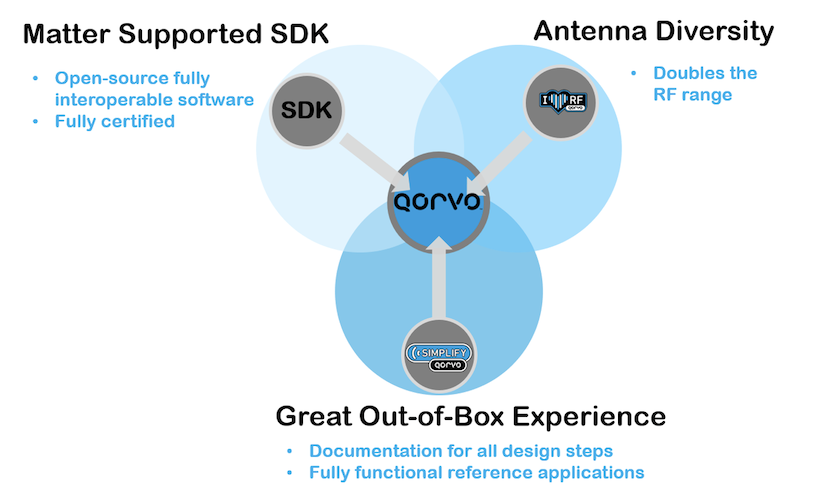
Qorvo supports design engineers by offering documentation that includes application notes, user manuals, and white papers. These resources assist in expediting development and making well-informed design decisions. Qorvo also provides a wide range of Wi-Fi front-end modules, Ultra-Wideband (UWB) solutions, power management SoCs, and input sensors to further help the development of wireless IoT systems (Figure 5).
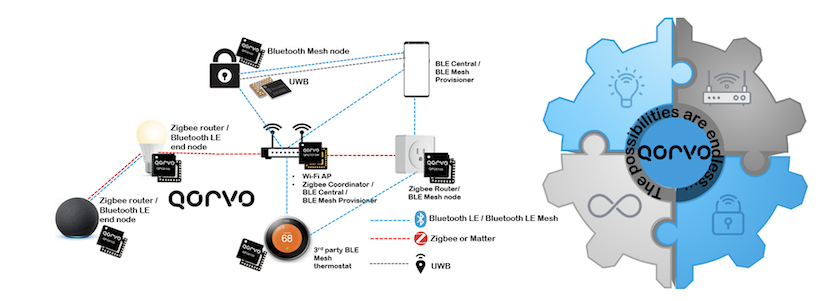
Moreover, ConcurrentConnect™ technology offered by Qorvo enables simultaneous operation of multiple IoT protocols such as Zigbee, Bluetooth LE, and Matter using a single radio. This technology supports dual radio use cases without the need for complex software multiplexing configurations. The concurrency is seamlessly handled in the silicon, allowing for the concurrent utilization of all Bluetooth LE use cases alongside Zigbee and/or Matter. While most IoT devices in a smart home rely on time division multiplexing for communication, Qorvo's ConcurrentConnect takes it a step further by ensuring reliable communication across IoT devices, regardless of the protocols employed.
In wireless system designs, maintaining an optimal RF signal range and preventing data dropouts are critical. Qorvo addresses these challenges by offering on-chip antenna diversity, a feature that seamlessly benefits system engineers. This hardware-driven feature works for all Zigbee and Matter solutions equipped with dual antennas. By incorporating antenna diversity, Qorvo's customers can reduce multipath fading, extend the RF range, and achieve robust signal performance in their IoT system applications. Qorvo's antenna diversity encompasses various advantages, including reliable communications through preamble switched antenna diversity, expanded RF signal coverage, decreased signal retries leading to extended device battery life, reduced service calls, minimized device placement issues, and improved RF signal link budget without Wi-Fi interference or under 2.4 GHz Wi-Fi interference.
Matter simplifies IoT devices from a standard perspective, while Qorvo’s ConcurrentConnect and antenna diversity technologies provide yet another level of ease of use. Qorvo's hardware SoCs eliminate fragmentation in IoT networks and streamline system design.

The CSA is the foundation and future of the Internet of Things (IoT). Established in 2002, its wide-ranging global membership collaborates to create and evolve universal open standards for the products transforming how we live, work and play. With its members’ deep and diverse expertise, robust certification programs, and a full suite of open IoT solutions—including Matter—they lead the movement toward a more intuitive, imaginative, and useful world.
Not only can you leverage Matter into your product for a full interoperability experience using Qorvo solutions, but you can now move toward new applications not yet developed using a complete array of network solution chipsets offered by Qorvo.
Learn more about Matter and how Qorvo is helping develop the IoT products of the future.
The Bluetooth® word mark and logos are registered trademarks owned by Bluetooth SIG, Inc. and any use of such marks by Qorvo US, Inc. is under license. Other trademarks and trade names are those of their respective owners.
Have another topic that you would like Qorvo experts to cover? Email your suggestions to the Qorvo Blog team and it could be featured in an upcoming post. Please include your contact information in the body of the email.
